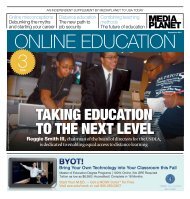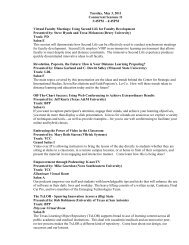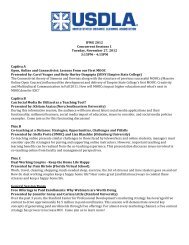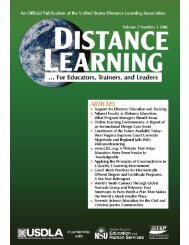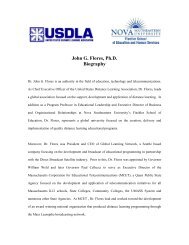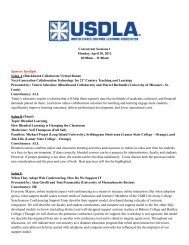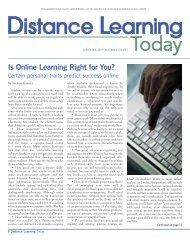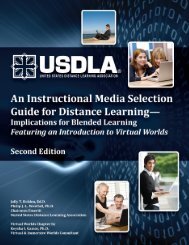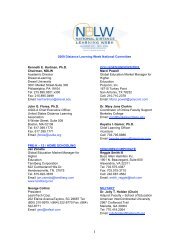United States Distance Learning Association
United States Distance Learning Association
United States Distance Learning Association
- No tags were found...
You also want an ePaper? Increase the reach of your titles
YUMPU automatically turns print PDFs into web optimized ePapers that Google loves.
Table 1.<br />
Goals of <strong>Learning</strong> Object Design<br />
Goals<br />
Reusability<br />
Interoperability<br />
Durability<br />
Accessibility<br />
Descriptions<br />
<strong>Learning</strong> content modularized into small units of instruction suitable for assembly and<br />
reassembly into a variety of courses<br />
Instructional units that interoperate with each other regardless of developer or<br />
learning management system<br />
Units of instruction that withstand ever-evolving delivery and presentation<br />
technologies without becoming unusable<br />
<strong>Learning</strong> content that is available anywhere, anytime—learning content that can be<br />
discovered and reused across networks<br />
Source: Web Based Training Information Center (2007).<br />
support learning” (Wiley, 2000). This definition,<br />
even though it is broad and allows<br />
for almost any item to be classified as a<br />
learning object, does narrow the field<br />
down to digital items only. The digital item<br />
is representative of what is used in the<br />
world of online instruction. In online<br />
instruction the learning object must be digital<br />
to allow for delivery to the student via<br />
technology. A very good analogy and<br />
excellent visual imaginary of what learning<br />
objects are is the LEGO metaphor (Wiley<br />
2000). The LEGO metaphor simply demonstrates<br />
how learning objects can be connected<br />
in various ways to create multiple<br />
learning experiences. A child can build<br />
many different items by using the same<br />
LEGO blocks by connecting them in different<br />
ways and combinations just like an<br />
instructor can build various learning experiences<br />
by connecting learning objects in<br />
different combinations.<br />
Another guiding factor in defining<br />
learning objects is the term “chunk.” Most<br />
learning objects are just small definable<br />
chunks of learning. They can be used as<br />
stand-alones or can be combined with<br />
other chunks to create a lesson or support<br />
a particular learning objective. The chunk<br />
factor could also be visualized as building<br />
blocks. Most of us are probably more familiar<br />
with the building block analogy, but<br />
most experts are now identifying learning<br />
objects as chunks to demonstrate their use<br />
in either linear or nonlinear learning,<br />
whereas the building blocks have always<br />
been associated with being able to build<br />
upon each other. This element is still viable<br />
with learning objects, but the terminology<br />
has changed some.<br />
<strong>Learning</strong> objects in their simplest form<br />
are quick items of instruction or information.<br />
They are designed to support the<br />
learning objectives of the course or training<br />
module and at times become the primary<br />
means of delivering the lesson. The<br />
whole premise of a learning object is<br />
developed around four basic goals; reusability,<br />
interoperability, durability, and<br />
accessibility (see Table 1).<br />
Imagine purchasing new equipment for<br />
a lab or multimedia equipment for a<br />
school. These four goals would probably<br />
be the same goals used to help make the<br />
decision of purchase. Is the equipment<br />
reusable Is it something that can be used<br />
throughout the entire school How durable<br />
is it Will it be accessible to the majority<br />
These are smart and logical questions<br />
that must be asked before designing and<br />
even using a learning object. Designers<br />
must build learning objects with these four<br />
goals in mind, and users must filter the<br />
objects they will use by gauging them<br />
against these same four goals.<br />
Other items must be looked at as well<br />
when deciding to use and/or build learning<br />
objects. First, why even build a learning<br />
object One of the main reasons always<br />
given is cost. To help limit expenditures,<br />
Volume 4, Issue 4 <strong>Distance</strong> <strong>Learning</strong> 75



